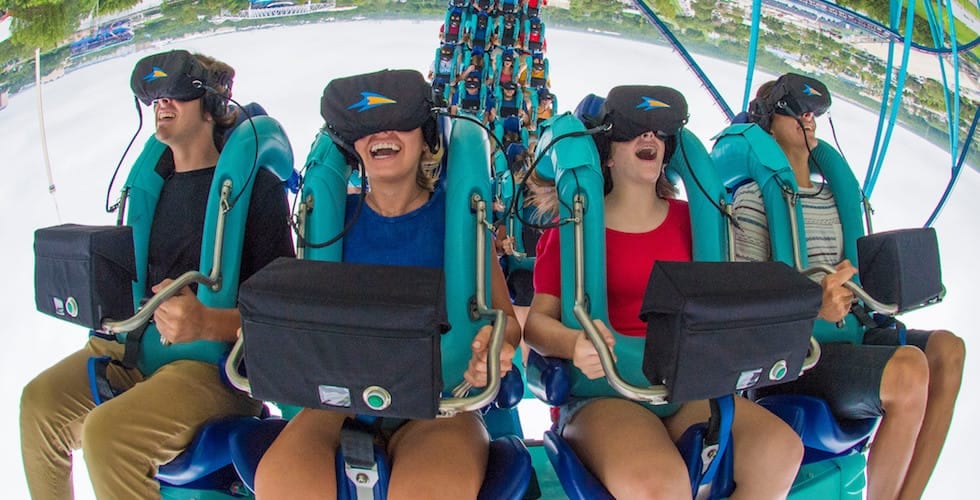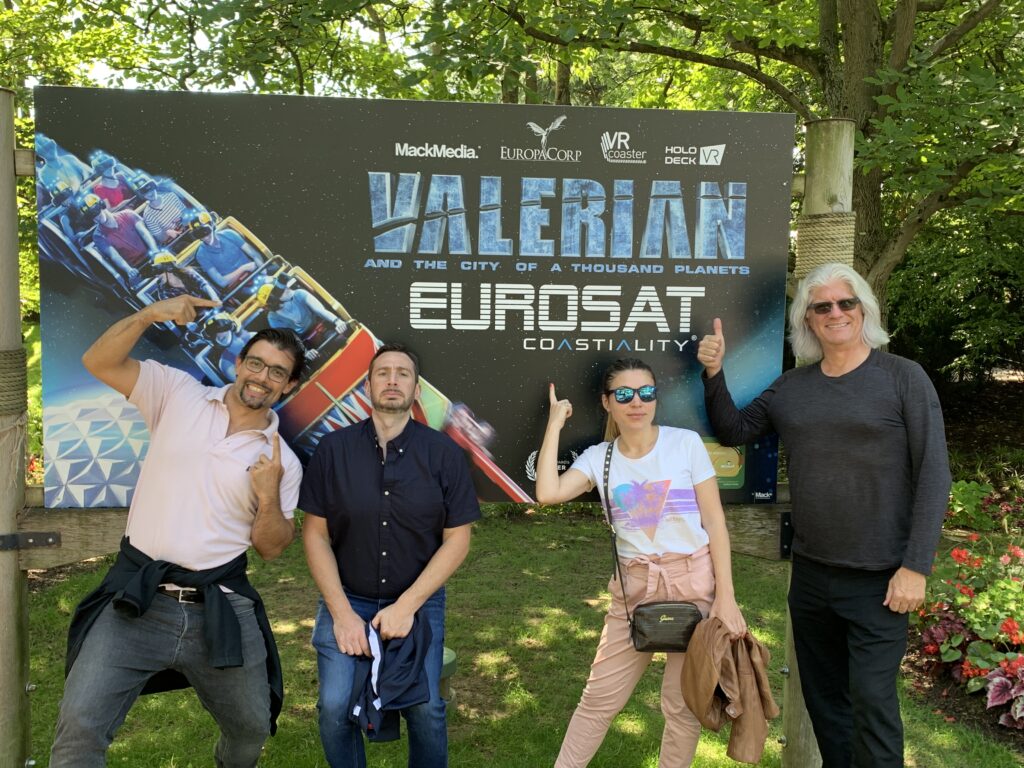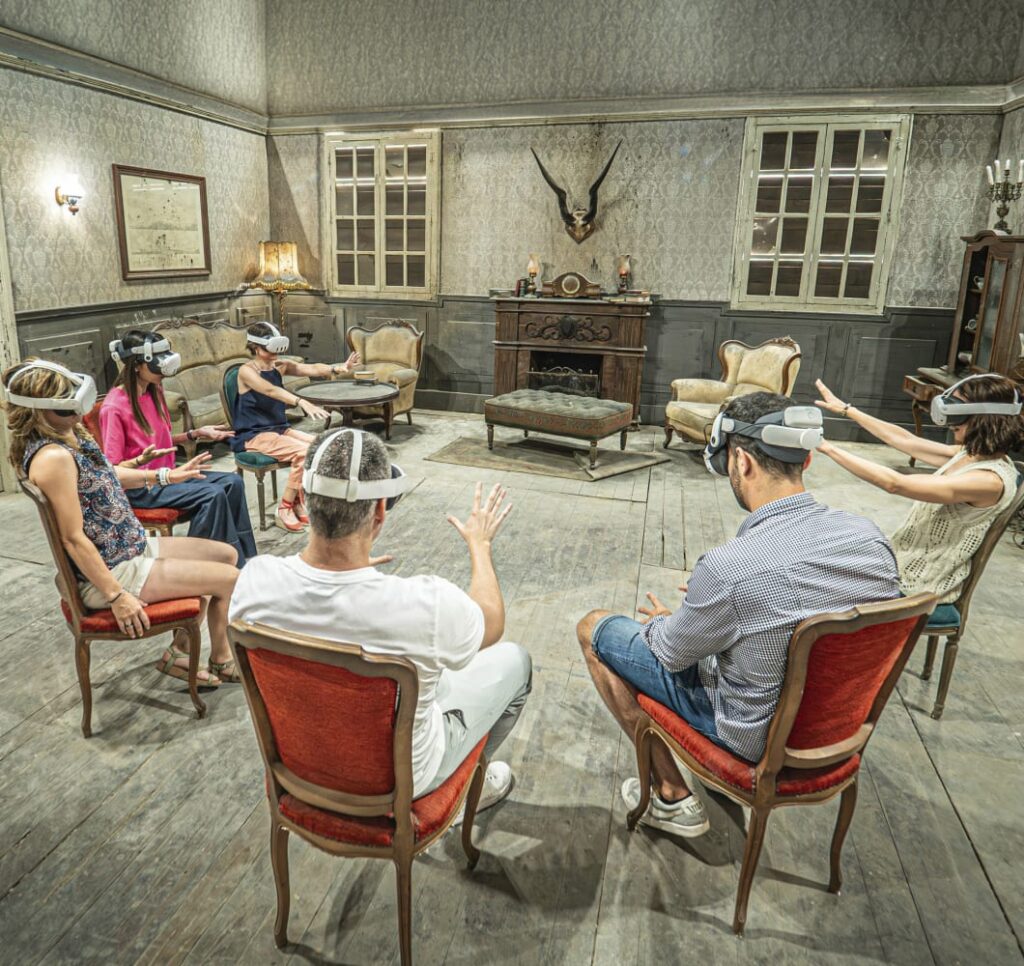
After IAAPA Barcelona, I was invited to tour PortAventura’s new mixed-reality attractions. I was curious to see how VR was being used in theme parks, since most earlier attempts had fallen short. After the experience, it’s crystal clear to me that we are on the precipice of a new age of downloadable theme park attractions.
The first wide-scale attempt to bring VR to theme parks was from VR Coaster, a division of Mack Rides in Germany. VR Coaster’s thesis was valid: use digital content to refresh aging steel or wood coasters. Most parks have roller coasters that are many decades old, some even half a century or more. For many coaster fans, these provide little more than a nostalgic trip around the track. They fail to capture the imagination of the current generations of coaster fans.
Mack believed that adding a digital layer of storytelling onto these coasters would blur the lines between a thrill ride and a dark ride. Since the coasters were tame by nature (and age), why not add a level of storytelling?
While the concept was sound, the technology wasn’t right yet. Onboarding and offboarding were slow and labor-intensive, reducing throughput and dramatically increasing labor costs. If the video synchronization in the headset was not perfectly aligned with the car’s motion, it could become nauseating. And since the front and rear cars create very different feelings in the rider, this was almost an unsolvable challenge.
At its height, VR Coaster had outfitted 70 roller coasters with VR headsets. Most were optional retrofits that generated extra per-capita revenue for the park to offset the cost of custom content creation for each ride, equipment purchases, and additional opex.

Bob with the former team from Spree VR, who collaborated with VR Coaster on Coastiality’s Roam and Ride technology.
But some parks went all-in on the VR coaster craze. The Mack family theme park, Europapark, opened Eurosat Coastiality in 2018. It was a retrofit of the original non-VR ride, themed after the French space opera, Valerian and the City of a Thousand Planets, by legendary director Luc Besson (who also directed the Fifth Element among other notable hit films.)
They called the tech Roam and Ride, where riders put on headsets in the queue and then had a free-roam pre-ride experience. They then attempted to board the cars while in virtual reality. It was a bold attempt but the tech wasn’t ready. Getting into the cars was clumsy and uncomfortable. And the tracking was way off in my experience. I had to close my eyes for much of the actual ride.

SeaWorld built a mega-coaster called Kraken with VR, but pretty quickly stripped the tech out. I’m not sure why anyone thought it was a good idea to put headsets on a brand-new mega-coaster. It just goes to show you how a hype cycle can drive unreasonable exuberance.
Post pandemic, there are few VR coasters left in the world. Coastiality, however, is still running, having been rethemed to Phantom of the Opera in collaboration with Andrew Lloyd Webber. I wonder if he actually rode it? VR Coaster is now part of an innovation company, MackNext, which continues to push the envelope in technology applied to theme parks. They’ve also designed the free-roam VR system, Yullbe, for arcades.
The main challenge of using VR in theme parks is throughput. Rides need to handle thousands of guests per day. For coasters, riders would get into the car, then put on the headsets, which required a staff member to spend more than a minute with each rider, slowing the queue to a crawl. It created pissed off customers and burned-out staff.
At Port Aventura, when we got into the queue for the El Diablo Neo coaster, we were given a Pico 4 Ultra headset while we waited for the train to arrive at the station. It was immediately in pass-through mode so that we could see the real world in full-color stereoscopic view. We were instructed to scan a QR code on the wall, and we were instantly in the scene. Easy peasy lemon squeezy.
When the train pulled into the station, getting into the car and pulling down the rail was just as easy as if we weren’t wearing the headset. The attendant, when he came by to check the safety bar, also clipped a carabiner on a strap on the back of the headset to a ring on the back of the car, so if the headset fell off, it didn’t turn into a projectile.
You can see the video of Kylie getting into the car on my LinkedIn post below. Make sure to follow or connect with me there for more insights that don’t make it into this newsletter.
As we sat in the car waiting for the ride to start, I looked to my right and saw a large wooden barrel with a bundle of dynamite sitting on top. I didn’t remember seeing it there before, so I lifted my headset and sure enough, it was a virtual object. As I glanced around, I noticed lots of theming elements I hadn’t noticed before: giant wooden beams, picks and shovels, mining equipment, and each time I lifted the headset to see if they were “real.” Most times, they were not.
Legendary special effects director of 2001: A Space Odyssey, Doug Trumbull, once told me that when your brain sees something in mixed or augmented reality, it assumes, since most of what is there is real, that the virtual objects are real too. I was definitely experiencing that phenomenon.
As the train started moving, I was girding myself for motion sickness. I used to love coasters, but now they can make me queasy—part of getting older, I guess. And I definitely can succumb to sim sickness if the motion tracking on a ride isn’t really well done. But the first thing I noticed was that, since I could see the real world, the tracking wouldn’t be an issue. There was no noticeable latency between the video feed on my headset and what my inner ear was sensing. It was smooth as butter.
I was seeing the coaster track as it was, and the trees, and the buildings, and even Kylie seated next to me. But then I noticed a dragon circling overhead. That was definitely not real, though that knowledge didn’t stop me from ducking when its fire breath appeared in front of me. And then there was a big stone statue swinging a giant hammer—duck again! Finally, there was a monstrous snake coiled around the track in front of us with its mouth agape. It swallowed the train, and suddenly we were inside the snake in full VR. It was a surprising twist that had us laughing with delight.
After the ride, I asked our hosts, Jordi Centelles and Andreu Tobella Brunet, who oversee PortAventura World’s digital innovations, what it would have cost to create those thematic elements using traditional hardscape and practical effects. They just looked at me and laughed. Bits are cheaper than atoms. This is the power of the downloadable theme park.

The Seance scene from Hysteria. You can’t see the scary things, but I could.
Next up was Hysteria, a walkthrough storytelling haunted house MR experience. It was installed in what seemed like a pop-up building. Wearing Meta Quest headsets (they’re working on the port to Pico now—because, well, I told you so), we watched a short video that set the story, then a door opened and we found ourselves in a room with six chairs. We sat down (I felt the need to make sure they were real, as I’ve made that mistake in VR before), and a seance began. Soon, there was a virtual Ouiji board on the floor, with ghouls floating around while the wind whipped the furniture into a whirling frenzy. The floor vibrated, and our ghostly host told us we’d better “Get OUT NOW!”
Not one to argue with a ghost, I moved through the various rooms as the story unfolded. There was fire, and dangling spiders, and all sorts of creepy theming. Some was real, some was not, but it all had a similar impact.
The entire experience was about 10 minutes. The park is charging 6 Euros per person, and utilization is extremely high. It’s performing so well that they’re building a third mixed-reality attraction now. It’s another walk-through experience in a larger, build-for-purpose permanent building that should open before the end of 2025.
The thing to understand: this is the worst that these experiences will ever be. And they’re already damn good. As innovative companies like PortAventura World and Mack continue to experiment and invest, the entire world will realize that downloadable attractions make not only financial sense but also provide amazing, highly repeatable experiences for guests.

